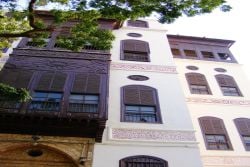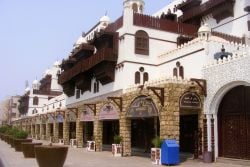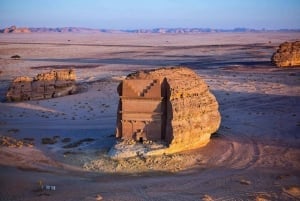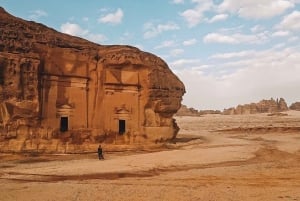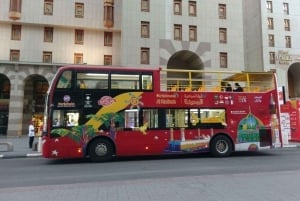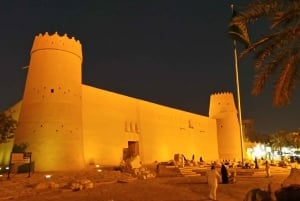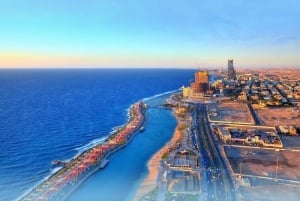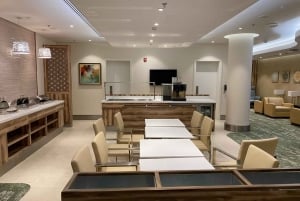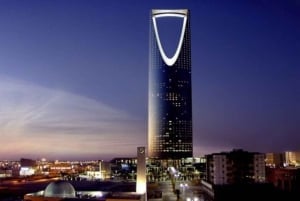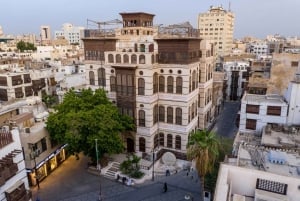Jeddah
Jeddah combines a rich history with a relaxed, modern ambiance as well as prime seaside location: on the shores of the Red Sea. It’s the largest city in the Kingdom’s second largest province of Makkah (not to be confused with the city of Mecca) and has the country’s busiest commercial port, Jeddah Islamic Port. Jeddah is commonly known as ‘The Bride of the Red Sea’.
And what a pair they make: the Jeddah cityscape cloaked in desert cream and fronted by the bright blue waters of the Red Sea.
The Jeddah Islamic Port and King Abdul-Aziz International Airport are the city’s main points of entry for millions of Muslim pilgrims arriving every year to visit Mecca and Medina.
According to popular belief, Jeddah holds the burial site of Eve; hence the name Jeddah, which means grandmother in Arabic.
The population of Jeddah is estimated at 4.2 million (2008 census), and the city is the most multicultural in the Kingdom, as a result of Muslim pilgrims opting to reside in the city after performing Hajj (pilgrimage) during the past centuries. Jeddah’s mixed community boasts inhabitants who once hailed from Africa, central and south-east Asia, Russia, Europe and the Middle East.
Jeddah started as a fishing village about 2500 years ago. Thanks to its proximity to North Africa and to major Middle Eastern cities, Jeddah is today a significant commercial center, often described as Saudi Arabia’s economic and tourism capital. In 2009, Jeddah was ranked 4th regionally for innovation in the Innovation Cities Index.
The downtown area, Al Balad, is truly historic with the ancient homes of fishermen renovated to their former glory. Constructed with a mix of clay, seashells and coral limestone, with wooden lattices for windows, a selection of these houses are open for public viewing.
Conceived by Jeddah’s former mayor Mohammad Said Farsi in the seventies to bring art and culture to Jeddah as well as inspire residents to interact with public spaces, a 30 kilometer stretch of coastal walkway called The Corniche was created. Not just a walkway, but an open-air gallery of sculptures, water fountains, children’s playgrounds, resorts, shops, aqua sports and scenic walks.
A wide range of local and international sculptors was selected for the Corniche open air museum project. Some of these include Paul Speld, Ottmar Hollmann, Mahmoud Banat, Henry Moore, Alexander Calder, Jean Arp, Joan Miró, and French master César Baldaccini.
With the Red Sea ranked as one of the top ten diving destinations in the world, Jeddah’s snorkeling and scuba diving experiences are truly magnificent. And that’s an understatement, considering we’re talking about a stretch of coral reefs visited by relatively very few tourists over the decades.
Residents of Jeddah see themselves as a distinctive bunch. The city’s annual summer festival, dubbed Jeddah Ghair – or Jeddah is Different – gathers over 2 million visitors from the region to view stage plays, art exhibitions, folklore performances, games, races, water sports competitions, bazaars and much more.
Jeddah’s corporate offices are located in King Abdullah Street while international brand high end shopping can be found mainly in Tahliya Street (Prince Mohammad bin Abdul Aziz Road). Other commercial stores are within the city’s countless mega malls. Traditional goods can be found in open air souks like Gabel Street and the old city (Balad) where one can take a break from shopping to ponder Jeddah’s history and centuries-old architecture.
Jeddah is home to one of the world’s highest water fountains. The King Fahd Fountain, otherwise known as Jeddah Fountain, shoots its jet of water to a height of 312 meters (1023 feet). The spectacular sight can be seen from quite a distance. The fountain runs continuously, using sea water propelled by huge pumps.
On a more cultural note, however, Jeddah’s list of museums and heritage sites is long. Here are a few of the most outstanding:
The Abdul Raouf Khalil Museum features an inside and outside museum experience. On the outside, a cluster of decoratively carved limestone buildings with masharabiyat (windows with wooden latticework) takes the visitor back to the 16th century Ottoman period. Inside, the visitor tours various displays from the Arabian Peninsula’s tribal civilizations through to the Ottoman era, ending with its most recent history as a modern state.
A museum whose façade was lovingly restored to its original Hejazi architecture, Beit Al-Balad or Municipality Museum, is a history museum dedicated to late 19th and early 20th century history of British intervention as the Ottoman occupation period ended during World War 1. It’s in this same building, now a museum, that British officers installed themselves and carved out the future of the Arab geo-political map.
The Naseef House, once a private residence built out of coral limestone and wooden beams in the late 19th century, is remarkable for its history, its internal and external architecture, and its tree. Yes, tree. A sapling planted in the courtyard at the time of construction was the only tree in Jeddah until the 1920s. It’s now the oldest tree in the city. Today, the house is used as both museum and cultural center.


